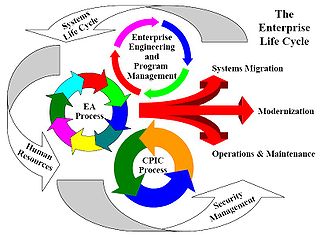Enterprise architecture (EA) is a business function concerned with the structures and behaviors of a business, especially business roles and processes that create and use business data. By international consensus, Enterprise Architecture has been defined as "a well-defined practice for conducting enterprise analysis, design, planning, and implementation, using a comprehensive approach at all times, for the successful development and execution of strategy. Enterprise architecture applies architecture principles and practices to guide organizations through the business, information, process, and technology changes necessary to execute their strategies. These practices utilize the various aspects of an enterprise to identify, motivate, and achieve these changes."

The Department of Defense Architecture Framework (DoDAF) is an architecture framework for the United States Department of Defense (DoD) that provides visualization infrastructure for specific stakeholders concerns through viewpoints organized by various views. These views are artifacts for visualizing, understanding, and assimilating the broad scope and complexities of an architecture description through tabular, structural, behavioral, ontological, pictorial, temporal, graphical, probabilistic, or alternative conceptual means. The current release is DoDAF 2.02.
A federal enterprise architecture framework (FEAF) is the U.S. reference enterprise architecture of a federal government. It provides a common approach for the integration of strategic, business and technology management as part of organization design and performance improvement.

Unicom System Architect is an enterprise architecture tool that is used by the business and technology departments of corporations and government agencies to model their business operations and the systems, applications, and databases that support them. System Architect is used to build architectures using various frameworks including TOGAF, ArchiMate, DoDAF, MODAF, NAF and standard method notations such as sysML, UML, BPMN, and relational data modeling. System Architect is developed by UNICOM Systems, a division of UNICOM Global, a United States-based company.

An enterprise architecture framework defines how to create and use an enterprise architecture. An architecture framework provides principles and practices for creating and using the architecture description of a system. It structures architects' thinking by dividing the architecture description into domains, layers, or views, and offers models - typically matrices and diagrams - for documenting each view. This allows for making systemic design decisions on all the components of the system and making long-term decisions around new design requirements, sustainability, and support.

Enterprise modelling is the abstract representation, description and definition of the structure, processes, information and resources of an identifiable business, government body, or other large organization.
Enterprise systems engineering (ESE) is the discipline that applies systems engineering to the design of an enterprise. As a discipline, it includes a body of knowledge, principles, and processes tailored to the design of enterprise systems.

John A. Zachman is an American business and IT consultant, early pioneer of enterprise architecture, chief executive officer of Zachman International, and originator of the Zachman Framework.

In the business sector, business architecture is a discipline that "represents holistic, multidimensional business views of: capabilities, end‐to‐end value delivery, information, and organizational structure; and the relationships among these business views and strategies, products, policies, initiatives, and stakeholders."
Business–IT alignment is a process in which a business organization uses information technology (IT) to achieve business objectives, such as improved financial performance or marketplace competitiveness. Some definitions focus more on outcomes that means ; for example,
Alignment is the capacity to demonstrate a positive relationship between information technologies and the accepted financial measures of performance.

Enterprise life cycle (ELC) in enterprise architecture is the dynamic, iterative process of changing the enterprise over time by incorporating new business processes, new technology, and new capabilities, as well as maintenance, disposition and disposal of existing elements of the enterprise.

A view model or viewpoints framework in systems engineering, software engineering, and enterprise engineering is a framework which defines a coherent set of views to be used in the construction of a system architecture, software architecture, or enterprise architecture. A view is a representation of a whole system from the perspective of a related set of concerns.
Business systems planning (BSP) is a method of analyzing, defining and designing the information architecture of organizations. It was introduced by IBM for internal use only in 1981, although initial work on BSP began during the early 1970s. BSP was later sold to organizations. It is a complex method dealing with interconnected data, processes, strategies, aims and organizational departments.

Treasury Enterprise Architecture Framework (TEAF) was an enterprise architecture framework for treasury, based on the Zachman Framework. It was developed by the US Department of the Treasury and published in July 2000. May 2012 this framework has been subsumed by evolving Federal Enterprise Architecture Policy as documented in "The Common Approach to Federal Enterprise Architecture".

Enterprise architecture planning (EAP) in enterprise architecture is the planning process of defining architectures for the use of information in support of the business and the plan for implementing those architectures.

NIST Enterprise Architecture Model is a late-1980s reference model for enterprise architecture. It defines an enterprise architecture by the interrelationship between an enterprise's business, information, and technology environments.

The Treasury Information System Architecture Framework (TISAF) is an early 1990s Enterprise Architecture framework to assist US Treasury Bureaus to develop their Enterprise Information System Architectures (EISAs).
This article documents the effort of the Health Level Seven(HL7) community and specifically the HL7 Architecture Board (ArB) to develop an interoperability framework that would support services, messages, and Clinical Document Architecture(CDA) ISO 10871.
Roger Evernden is a British enterprise architect, musician, composer, writer and speaker.
The history of business architecture has its origins in the 1980s. In the next decades business architecture has developed into a discipline of "cross-organizational design of the business as a whole" closely related to enterprise architecture. The concept of business architecture has been proposed as a blueprint of the enterprise, as a business strategy, and also as the representation of a business design.


































